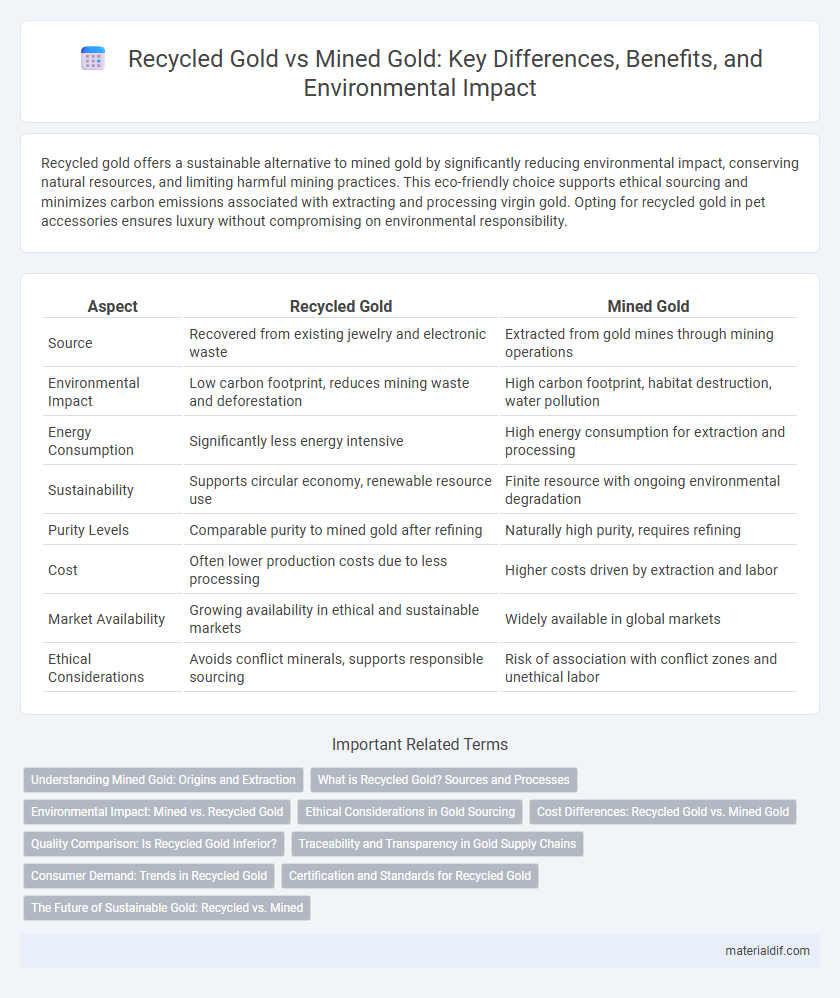Recycled gold offers a sustainable alternative to mined gold by significantly reducing environmental impact, conserving natural resources, and limiting harmful mining practices. This eco-friendly choice supports ethical sourcing and minimizes carbon emissions associated with extracting and processing virgin gold. Opting for recycled gold in pet accessories ensures luxury without compromising on environmental responsibility.
Table of Comparison
| Aspect | Recycled Gold | Mined Gold |
|---|---|---|
| Source | Recovered from existing jewelry and electronic waste | Extracted from gold mines through mining operations |
| Environmental Impact | Low carbon footprint, reduces mining waste and deforestation | High carbon footprint, habitat destruction, water pollution |
| Energy Consumption | Significantly less energy intensive | High energy consumption for extraction and processing |
| Sustainability | Supports circular economy, renewable resource use | Finite resource with ongoing environmental degradation |
| Purity Levels | Comparable purity to mined gold after refining | Naturally high purity, requires refining |
| Cost | Often lower production costs due to less processing | Higher costs driven by extraction and labor |
| Market Availability | Growing availability in ethical and sustainable markets | Widely available in global markets |
| Ethical Considerations | Avoids conflict minerals, supports responsible sourcing | Risk of association with conflict zones and unethical labor |
Understanding Mined Gold: Origins and Extraction
Mined gold is extracted through intensive processes involving hard rock mining, placer mining, or by-product mining, where ore containing gold is drilled, blasted, and processed to separate gold from other minerals. Originating from deep within the Earth's crust, mined gold deposits are formed over millions of years through geological processes like volcanic activity and hydrothermal circulation. The environmental impact of mined gold includes significant land disturbance, energy consumption, and chemical use, prompting a growing shift toward sustainable practices in the mining industry.
What is Recycled Gold? Sources and Processes
Recycled gold refers to gold that has been reclaimed from old jewelry, electronic components, and industrial waste, reducing the demand for newly mined gold. Key sources include discarded electronics, obsolete dental materials, and scrap jewelry, which are collected and processed through melting, refining, and purification to restore the metal's original quality. This sustainable practice minimizes environmental impact and conserves natural resources compared to traditional gold mining.
Environmental Impact: Mined vs. Recycled Gold
Recycled gold significantly reduces environmental impact by eliminating the need for energy-intensive mining processes and minimizing habitat destruction, water pollution, and carbon emissions. Mining gold involves extensive land disruption, toxic chemical use such as cyanide and mercury, and significant greenhouse gas emissions estimated at 20-25 kg CO2 per gram of gold mined. Choosing recycled gold promotes sustainable practices by conserving natural resources and reducing the ecological footprint associated with traditional gold extraction.
Ethical Considerations in Gold Sourcing
Recycled gold significantly reduces environmental impact by minimizing the need for destructive mining practices, preserving natural habitats and reducing carbon emissions. Mined gold often involves unethical labor practices, including exploitation and unsafe working conditions in developing countries, raising serious human rights concerns. Choosing recycled gold supports sustainable sourcing and aligns with ethical standards by avoiding the social and ecological damage associated with traditional mining.
Cost Differences: Recycled Gold vs. Mined Gold
Recycled gold typically costs 20-30% less than mined gold due to lower extraction and processing expenses. Mining gold requires extensive labor, heavy machinery, and environmental remediation, driving up its price significantly. The cost-efficiency of recycled gold makes it an increasingly attractive option for sustainable jewelry and investment markets.
Quality Comparison: Is Recycled Gold Inferior?
Recycled gold matches mined gold in purity and quality, often refined to 99.99% purity, ensuring no compromise in durability or appearance. Advances in refining technology allow recycled gold to be indistinguishable from newly mined gold in jewelry and electronics applications. Both sources meet stringent industry standards, making recycled gold equally reliable for high-quality uses.
Traceability and Transparency in Gold Supply Chains
Recycled gold offers superior traceability and transparency compared to mined gold due to detailed documentation of its origin and previous ownership, enabling clear tracking throughout the supply chain. Mined gold often faces challenges in transparency, with complex extraction processes and potential ethical concerns, making it difficult to verify its source and environmental impact reliably. Increasing demand for responsible sourcing has pushed the industry to adopt blockchain and certification technologies to enhance visibility and accountability in both recycled and mined gold supply chains.
Consumer Demand: Trends in Recycled Gold
Consumer demand for recycled gold has surged due to growing environmental awareness and ethical considerations in the jewelry market. Recycled gold offers a sustainable alternative to traditional mining, minimizing ecological impact and reducing carbon emissions associated with extraction processes. Market trends indicate increasing preferences for recycled gold in luxury brands, reflecting a shift towards responsible sourcing and circular economy principles.
Certification and Standards for Recycled Gold
Recycled gold is increasingly certified under rigorous standards like the Responsible Jewellery Council (RJC) and Fairmined, ensuring ethical sourcing and reduced environmental impact compared to mined gold. These certifications guarantee traceability, fair labor practices, and minimal ecological disruption throughout the gold supply chain. As sustainable practices gain prominence, certified recycled gold offers a verified alternative that addresses the environmental and social concerns associated with traditional gold mining.
The Future of Sustainable Gold: Recycled vs. Mined
Recycled gold significantly reduces environmental impact by minimizing habitat destruction and carbon emissions compared to traditional mining, which consumes vast amounts of water and energy. Advances in recycling technologies are making recycled gold purer and more accessible, driving its demand within sustainable jewelry and electronics industries. As regulatory pressures on mining increase, recycled gold is poised to become the dominant source, aligning with global goals for circular economy and responsible sourcing.
Recycled Gold vs Mined Gold Infographic

 materialdif.com
materialdif.com